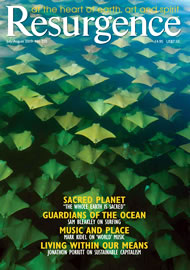Back in 1984, the nascent Lilliput Press published a pamphlet that began: “For some years I have spent a few weeks of each spring and autumn walking the southern coast of Connemara. It is a strange region.” The author was a Yorkshireman called Tim Robinson who had just moved to the area from the Aran Islands. Thus began the extraordinary project to map, both literally and in words, the deep geographies of his adopted homes in western Ireland, resulting in the two-volume Stones of Aran and the projected Connemara trilogy – of which The Last Pool of Darkness is the second volume.
Ironically, Robinson was drawn to Connemara because of the “near unmappability” of its tangle of a coastline, balanced by the vast and apparently featureless bogs of the interior. Concerned as much with the unmeasurable as the measurable, he extends the obsessive nature of mapmaking into his essays, which gives them a dimension of urgency missing from most celebrations of place. Whether discussing the Cleggan tragedy, an abandoned lighthouse, the tombs in Ballynakill or the life
cycle of a barnacle, Robinson’s voice is as steady as it is lyrical – and accurate as a theodolite: the song of a corncrake is “a precise seam of so many stitches”; a harsh slope looks out to “a sea full of rocks the waves fight over”.
The first volume, Listening to the Wind, kept close to Robinson’s home in Roundstone, or explored the interior. The Last Pool of Darkness surveys the north-western coastline and its islands, opening with a compelling account of the area’s laval geology, its “rippings” taking place over hundreds of millions of years. “What appals and exhilarates me in the contemplation of these shiftings of matter… is that none of it mattered.” This existential darkness lies just behind the glittering details of the present, and connects in some way with the painful human past of this “serious, ascetic” region, reaching a climax in the 19th-century Great Famine – a horror which shadows the entire book.
If a few hundred square yards of Connemara saw both the first-ever radio signal sent from Marconi’s station (destroyed, like so much else, in the Civil War), and the completion of the first trans-Atlantic flight with Alcock’s biplane nose-down in the bog, it mostly resounded to the anonymous scratching-out of countless livelihoods under landlords either mean, indifferent or benign, and a depressingly bloody litany of feuds and avengings. Robinson leaves no stone manor or castle unturned: usually accompanied with a boom-and-bust rota of unfulfilled dreams and abrupt changes in ownership, the complexity of even the shortest history shows how our assumptions of a stable family continuity are illusory.
Early hermits flocked to this westernmost region, and Robinson scrambles among sheep-droppings to illuminate the debris of once-sacred times; he sees a 12th-century roofless chapel on its eponymous island as “an intensification and perfecting of the island’s being”, the masonry making recent stonework “look like exercises in bad taste”. His obsessive research turns up surprises: on High Island, for instance, it was not so much a “hermitage…attentive only to the spirit, but a busy, organised settlement, full of the sound of iron against rock”.
A search for the legendary Loch na Niadh, where a favourite traditional song in Irish has its bard meet a young queen of Greece, ends up contemplating a pond on a golf course, the “old, magical, poetic times subsisting in the heedless heart of contemporary banality”; typically (if reluctantly), the rough’s floral richness is acknowledged.
It was Wittgenstein who, seeking a remote place to live and think, called Connemara “one of the last pools of darkness in Europe”; there is a vivid chapter on his stay in the now-dismal village of Rosroe, where he was visited by a long-suffering Bertrand Russell between problems with the neighbours and their dogs. Robinson, a Cambridge mathematics graduate, even has a go at explaining Wittgenstein’s theories; here as elsewhere in the book, the sudden burst of high philosophical contemplation is compelling.
Perhaps the most remarkable riff, however, is ignited by a ghastly, gable-happy hotel extension on the machair of Iorras Iasc (‘promontory of fish’). Robinson wonders if such degradation, a product of the new ‘postmodern Ireland’, might create “some Anticonnemara that threatens to neutralise the place, to drag it down into globalised nullity”. Since Connemara is one of the “deep places…that demand fidelity to their truth” – as much a state of mind as a place – it seems particularly vulnerable. By illuminating its depths, Robinson’s superb book plays a
vital part in resisting the torrent of glib shallowness by which our toeholds on life’s profundities are continually threatened, wherever we may be.







